After many years of testing GPS watches, I was intrigued by the flood of runners falling in love with COROS. So of course I had to put it to the test against one of the long standing giants: COROS vs Garmin!
While both brands are looking to suit the needs of beginners to long distance trail runners, I find the watches to have quite a few differences.
A few of the major differences with COROS vs Garmin sport watches:
- Garmin wants to be part of your ENTIRE life, with cycle tracking, daily events, etc
- COROS is focused on your training and streamlining things
With so many GPS watches available at varying price points, it can be overwhelming to go through all of the reviews to figure out which one is right for you. The first step is to narrow down to a brand that fits you.
I’ve compared Suunto vs Garmin and Polar vs Suunto previous articles, and this time I’m pitting COROS vs Garmin.
Are COROS watches any good?
After testing multiple watches, I can see why many users have fallen head over heels for them (including Coach Stacey who helps to balance that I don’t particularly love them). The GPS appears to be very accurate, it has some amazing app features and streamlined watch navigation.
The main drawback I ran in to was with HR readings and potentially the single dial, which I’ll detail below.
Not interested in all the research and just want to know what I’d pick?✅This is the watch I’d choose as a beginner.
It has more than enough features to last you through that first 5K all the way through many marathons and is more cost effective than other options.
COROS Vs Garmin Watch Feature Comparison
Nearly every watch now includes some standard features like heart rate monitor, pace, distance, calorie tracking, recovery time and lap function.
Where the two brands differ is in the watch navigation, screens and app. Both of these brands have STELLAR apps, which add to the appeal of the watch.
I’m going to go through some overviews of the features and below that some head to head comparisons for budget, mid-range and high level watches.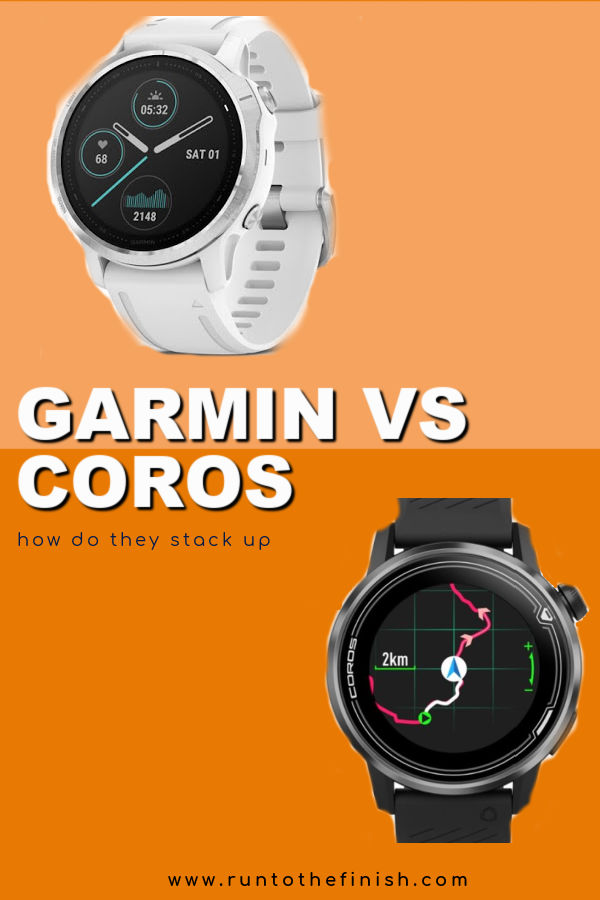
Watch Usage – Tie
The biggest difference between the two brands is how you actually use the watch.
- COROS has a dial on the side to navigate.
- Garmin has at least 4 buttons with two on each side.
Some users LOVE the dial and find it far simpler. I’m so used to the buttons, that I was not as enamored.
I fully detailed how the dial works in my COROS Apex Review. It was easy enough for finding a training mode, but once in the mode felt harder to get what I wanted.
Screen Display and Tracking – Tie
The screen display vibrancy is now a win for Garmin if you have one of their AMOLED watches like the photo below. It’s so much more vivid than the COROS.
Both Garmin and COROS watches display customizable real-time data, such as pace, time, distance run, calories burned, and heart rate, plus more if you desire. Summary information like average pace, stride count, and elevation gain are all also available real-time by the push of a button.
Additionally, you can set up structured workouts and customize your screen display.
The biggest difference between the two brands in this arena comes in the updates.
When COROS makes a functional update they push it out to all watches, rather than it being only for new models. This is something that many COROS users rave about.
What’s that mean? When COROS added a new feature for structured workouts or running power, that became available on all models. Often with Garmin new large features become only available in new watches.
AND NOW that many of the Garmin watches have the new AMOLED screens they are so much brighter and more brilliant than anything I’ve tested previously, it’s very enticing.
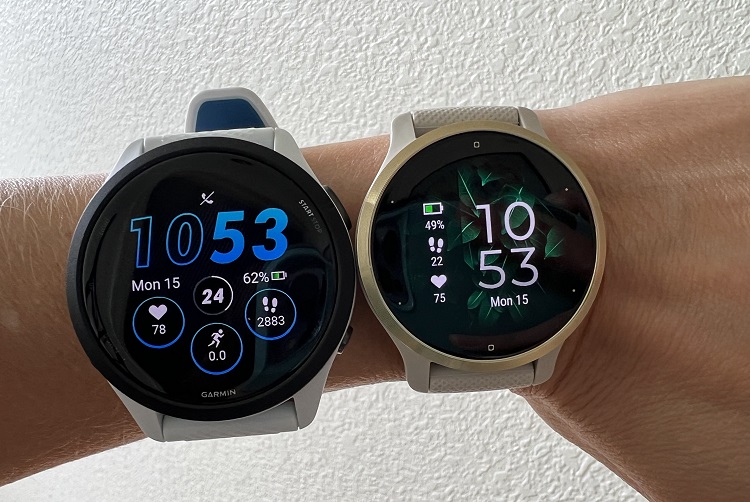
GPS Watch Battery Life – COROS
Most COROS watches have an average GPS battery life of 30 hours and regular use about 30 days. They have GPS save modes which can double the GPS life. In testing the Apex and Pace, I didn’t find they to last 30 days, but certainly long batteries.
While the budget and mid-range Garmin models are closer to 14 hours of GPS battery life and 7 days usage.
However, the Garmin Fenix 7 and Forerunner 955 can switch to UltraTrac mode, which sacrifices GPS accuracy in exchange for a longer battery life, up to 60 hours. UltraTrac mode is a battery saving feature that periodically shuts off GPS and uses the accelerometer to determine speed and distance.
**Click here if you’re looking for which GPS watch lasts the longest.
Mapping and Navigation – Tie
For those running new routes or who have a tendency to get turned around during a run, the navigational features on Garmin and COROS watches will make sure you stay on course and return home safely.
On mid and high end models you’ll find:
- Breadcrumb navigation
- Downloading routes
- Back to start navigation
If you don’t mind looking at a map on a tiny screen, the Garmin Fenix series and Garmin Enduro includes color topographic mapping capabilities.
Heart Rate Monitoring – Tie
These days, most GPS watches come with either strap-based or wrist-based optical heart rate monitors.
Optical monitors are known to provide inaccurate results due to recording random movements, however the Polar Vantage series has the only watches currently available on the market that use bio-impedance technology to override readings caused by movement.
- COROS all models were extremely inaccurate for me (the new Pace 3 with an updated monitor is much better)
- Garmin models fluctuate in accuracy (more expensive did not mean more accurate, right now the Enduro and 265 have been most accurate)
Both brands track wellness-related data like sleep metrics and heart rate throughout the day.
The difference between the two brands is that all of the COROS watches include some variation of this feature, where Garmin has a few models that do not.
Since training using low heart rate training I’ve come to understand the relevance of using a heart rate monitor to complement my training. All of the Polar watches and the higher end watches in the Garmin lineup include wrist-based and or optical heart rate monitoring.
For some tricks on getting more accurate heart rate readings check out my GPS watch tips.
Data Management and Apps – Tie
Both brands have apps that allow you to see more details about each individual workout, your total workouts, sleep data and to manage your data. But they also have some differences.
Garmin uses a program called Connect which allows you to earn badges for different activities, which many people find highly motivating. MORE importantly it lets you track your hormonal cycle, which can be eye opening for female athletes.
COROS does not have the cycle tracking, but does have a feature that allows you to build strength training workouts from a library. I like this integration because it helps to ensure runners are doing their strength work.

If you’re switching between brands, then an app like Strava is probably the best place to keep all of your data safely in one place.
COROS vs Garmin Watch Comparison
Click any link below to see the watch and additional function details, watches are divided in to budget, mid-range and high end to help you compare models.
If you want a complete comparison of just the differences in Garmins, checkout my article on the best Garmin watches for runners.
Budget Watches
Both watches work for running, biking and swimming. As well as tracking HR, phone notifications on the watch and providing structured workouts. Below I’ll call out key differences.
Coros Pace 3 ($229)
It’s interesting that people originally said they chose COROS because it was cheaper, but I’m not seeing that with the newer models that have advanced to be on par with other brands.
The COROS Pace 3 with entirely new HR sensors may finally get me to recommend these watches!! Thus far in my few runs it has worked, where as I could never get any previous model to be remotely accurate.
COROS Pace 3 is its lightweight design, weighing in at just 30 grams and very small watch size. This makes it one of the lightest GPS sports watches on the market, ensuring that it won’t weigh you down during your runs.
Despite its compact size, the Pace 3 still manages to deliver excellent battery life, offering up to 38 hours of continuous GPS tracking, making it suitable for long-distance runs and ultra-marathons. Though it’s not a rugged watch by any means.
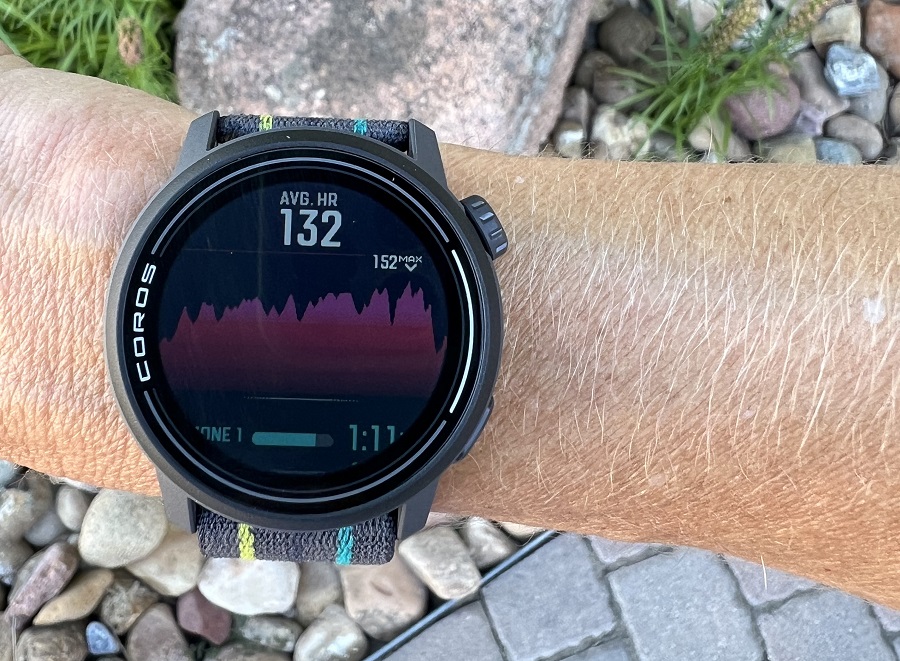
- Triathlon mode
- Open water swim mode
- Barometric altimeter (more accurate elevation)
- Up to 38 hour GPS life
- Read my full Coros Pace 3 Review
Garmin Forerunner 55 ($199)
This is now what’s considered an entry level running watch and it has EVERYTHING including smart watch features. You can go more basic with the Garmin 25, but it’s not well supported now. With the 55 you’ll get wrist based HR, GPS features, Safety features and more.
Having tested this watch, I’m impressed. For entry level, it really has so much more than most runners need.
While the Forerunner 55 is packed with features, it looks and feels cheaper. Unlike the Fenix which comes in lovely white and rose gold, giving it a wear anytime look, the 55 feels almost plastic. It also does NOT include the ability to provide elevation, ascent, descent, mapping or a few other things you’ll see in a higher end model.

- Includes location streaming safety feature
- Records PRS
- No Swim tracking
- Up to 24 hour GPS life
- Read my full Garmin 55 review to compare to other Garmin models
It’s a great value when I think I paid this price for my first Garmin that could only track how far I ran!
Midrange Watches
This used to be a $100 upgraded, but now it’s more like $200 because they just keep throwing more and more and more in to these watches. The mid-range watches which have a few more features like maps, longer battery life, more sports, etc.
Following are some of the key differences. Part of the upgrade is the style and materials of the watch making it more durable.
COROS Apex 2 Pro ($449)
One of the standout features of the COROS Apex 2 Pro is its exceptional battery life.
It utilizes an intelligent power optimization system that allows it to last for extended periods, even during long-distance runs or multi-day events. With up to 100 hours of continuous GPS tracking, you can rely on this watch to keep up with your endurance training without worrying about running out of battery.
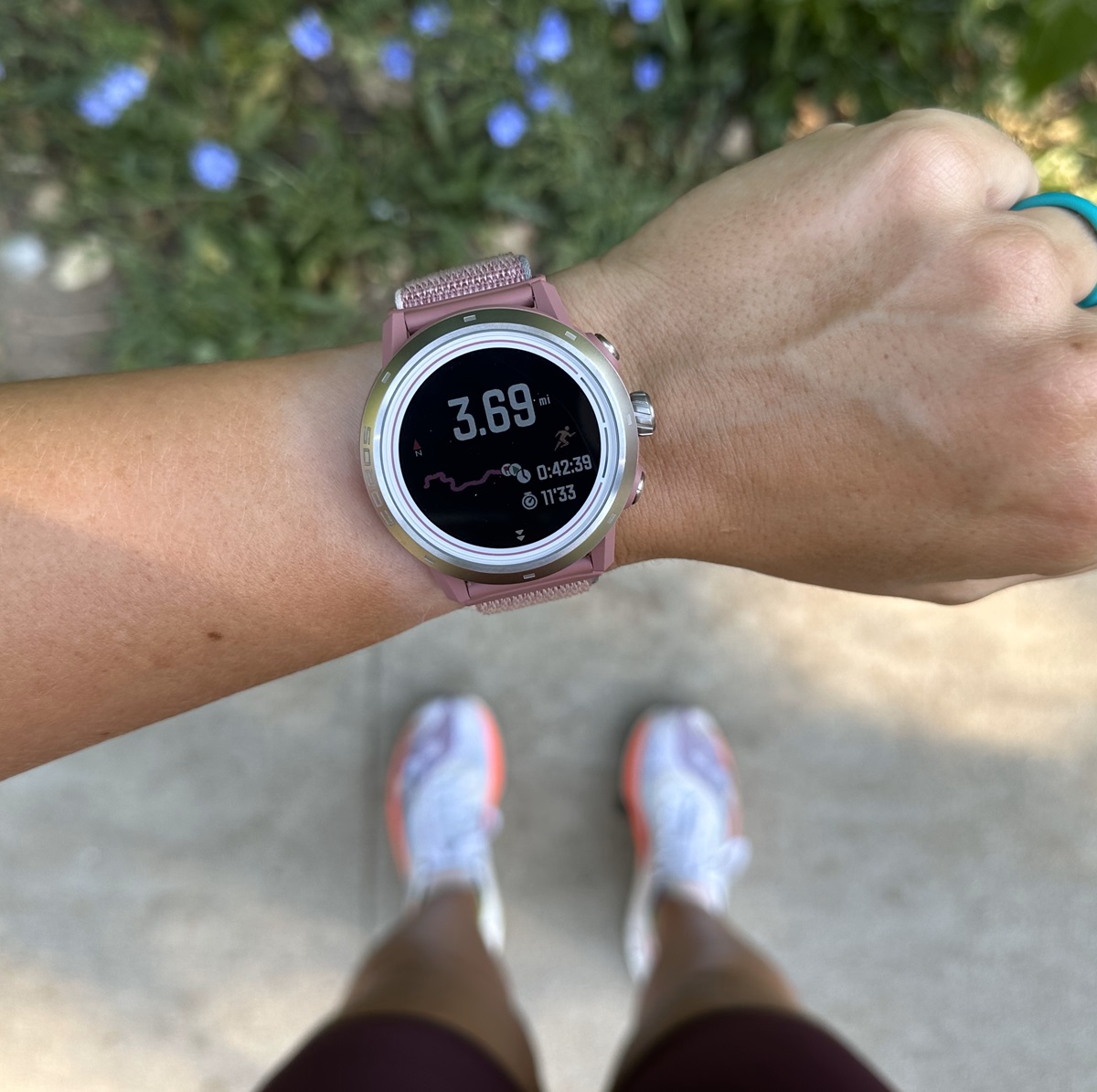
It provides precise distance, speed, and elevation measurements, along with advanced metrics such as running cadence, stride length, and ground contact time.
The COROS Apex 2 Pro features a durable construction that can withstand harsh conditions and is water-resistant up to 50 meters. It offers a clear and easy-to-read display, even in bright sunlight, and its intuitive interface makes it effortless to navigate through various functions and settings.
The watch also supports smartphone notifications, allowing you to stay connected without needing to reach for your phone during your runs.
There is also an Apex 2, which is slightly less expensive and better if you have a smaller wrist.
- Up to 40 hours GPS life
- 8 GB of internal memory
- Record HR underwater
Garmin Forerunner 265 ($449)
This watch will track running, swimming, and cycling and tell you your ground contact time balance, stride length, and more. Plus, the screen is just gorgeous.
The colors on this watch are brilliant and so far, I’m seeing good things with the accuracy of the HR readings as well. I’m not always a fan of the touch screen with winter running, but it does mean you don’t have to remember how to use all the buttons!
Right now this has been my go to watch for road and treadmill runs.

- Up to 30 hours GPS life
- Custom apps downloaded to watch
- Performance training metrics
- Follow GPS track back to start
- Download GPS routes, Live Tracking
- Run/Walk Mode
- Garmin Pay
Note: We believe this model is being phased out for the new Garmin 570. Price point is a little higher, it has a few more features, but we still think the 265 is one of the best options so snag it now!
The Forerunner 245 is the one of the previous models that was available and it’s got nearly the same features for about $200 less. But it doesn’t have that incredible display.
High End Watches
Now we’re taking the materials up a notch and adding in a few additional features that make these watches even better for a trail run and those spending a lot more time in the great wide outdoors.
You’ll also find sapphire glass which is less likely to scratch and again an upgrade in materials.
Do we often need everything on these watches…no.
Do they often look cooler…yes.
The Garmin Fenix S series is focused on creating a smaller watch to fit on a smaller wrist, so that it can look like a timepiece you want to wear all day long. Listen the rose gold sold me!
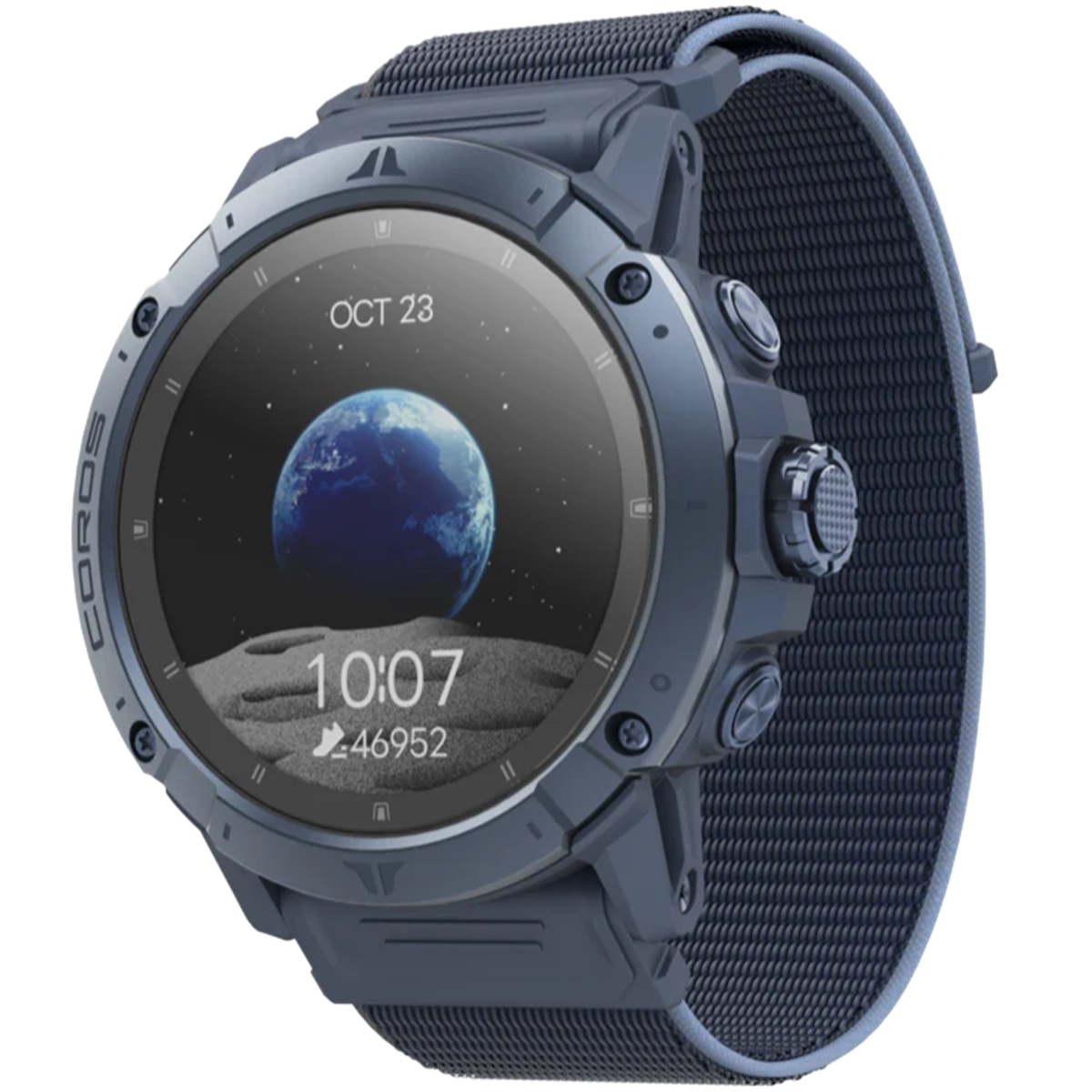
Coros Vertix 2 S ($699)
This is the one watch I have no yet tested, but again have many trail friends who just LOVE their COROS watches. So I feel comfortable suggesting it, as long as you read the notes above.
The Coros Vertix 2S is a robust and advanced GPS adventure watch designed to cater to the needs of outdoor enthusiasts, mountaineers, and athletes who engage in extreme activities. This rugged timepiece offers a wide range of features and durability that make it a reliable companion in challenging environments.
One of the standout features of the Coros Vertix 2S is its exceptional durability and resistance to harsh conditions. It is built to withstand extreme temperatures, shock, and impact, making it suitable for adventures in rugged terrains. The watch is also water-resistant up to 150 meters, ensuring it can handle swimming, diving, and other water activities without any issues.
- 118 hours GPS battery life
- Detailed maps for running and tracking
- Touchscreen and Sapphire glass to protect from breaking
- 3GB of music storage on the watch
- Running dynamics like vertical oscillation, ground contact
- Track sensor – more accurately calculates your workout when running on a track
Garmin Fenix 8 ($1199)
This watch is for the athlete who wants their watch to just know what they’re doing. It’s going to have every bell and whistle we’ve discussed previously, plus the components are upgraded.
The Fenix can tell the difference if you’re running indoors vs outside vs on the road or trail. It knows if you’re in a pool or swimming in open water. It can even give you an accurate weather forecast via Bluetooth.
Truly this watch has more sport features than any other on the market and is one of the few rated for diving.

- 84 hours GPS life
- Optional solar option (love this feature)
- Dive rated
- Voice control your watch and apps (also text!)
- Download custom apps
- Contactless payments
- Topographical maps
- Virtual racer
- Weather
- So many fitness tracking styles from XC ski, to Climbing to HIIT workouts
The other top end watch you might see is the Garmin Enduro. I loved running with this watch, but it is VERY large and I would say really designed more for those doing a lot of ultramarathons or backcountry hiking.
💰Right now you can get the Fenix 6 and 7s at a huge discount because they’re rolling out the new Fenix series, which includes the new Solar version. That’s right, a watch that charges on the go!!
See my full review of the Garmin Fenix 7s. The 8 does have some upgrades like the built in flash light and the voice control, but most of the other features remain the same.
The COROS Vs Garmin comparison feels anything but straightforward to me. The have a different feel, different style and almost a different marketing to who their user is.
It really comes down to do you like the dial on the side, do you like that they’re light weight and maybe focused more on training than some of the lifestyle factors.
What to read next?
Checkout our full page of my must have running gear reviews and guides to save you time searching and money! I share what’s worked for me and fellow runners, along with what wasn’t worth the price tag.
A few common requests:
- Garmin Vs Polar
- Coros GPS Watch Review
- Garmin Forerunner 55 Review
- How to use all your run data
- Best HR monitors (from watches to straps)
- Best wireless headphones for running
Other watches you want to know about? Let me know!
Other ways to connect with Amanda
Instagram Daily Fun: RunToTheFinish
Facebook Community Chatter: RunToTheFinish
Sign Up to Receive a Weekly Newsletter with Top Running Tips and Laughs



 Adidas Supernova Rise 2 Review | Better on Paper
Adidas Supernova Rise 2 Review | Better on Paper
